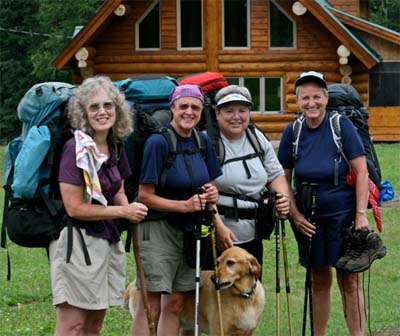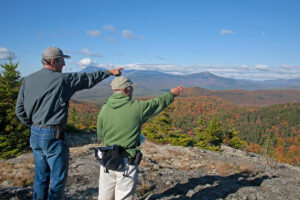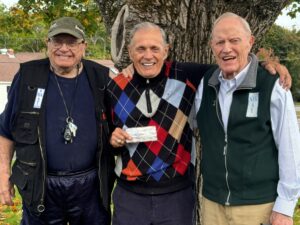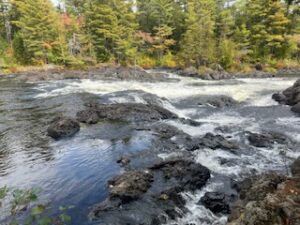
Latona Torrey, Joan Hildreth, Pat Huntley and Linda Ives
In case you are wondering, “where are they now?” here is a quick update. We departed from Maine, July 6, and began hiking with two other friends in Perth Andover, New Brunswick. We had decided to skip the 100-mile section of the IAT in Maine and go for the New Brunswick/Quebec sections because of time constraints and a strong desire to make it to Cap Gaspé at the point of land where the Appalachian Chain “drops” into the Atlantic. We planned two months to hike this section.
We traveled through New Brunswick being treated like celebrities, or long lost friends, by the local people in the towns of Plaster Rock, Nictau and Saint Quentin. One of our friends developed severe blisters and we stopped in Kedgwick, first to see a doctor for advice, and then at a camp along the Kedgwick River for some R&R for her feet. Recuperation was slow, and she decided to get off the trail.
At this point, now three of us remaining, we had a choice of hiking, or traveling 65 miles via canoe on the Restigouche River – a pristine salmon river – and chose this opportunity. We paddled about 22 miles each day and camped along the river, often seeing the salmon swimming below us, or leaping above the river, and once being landed by an accomplished fishermen. That one was well-over three feet long. The end point of this river experience was floating into Matapedia, Quebec.
Here, we believed we would leave the road walks and flat rails-to-trails of New Brunswick and enter the more challenging wooded, mountainous hiking of Quebec. How true that would prove to be. We hiked out of Matapedia with full-packs – about 35 pounds with food, tent, clothes and the other essential to remain safe and “comfortable” as we journeyed. The shelters that we found during the first few days were beautiful cabins called refuges. The first was called Le Turcotte and sat on the edge of a beaver pond. We enjoyed the beaver family’s work and play all evening.
The second and third day we spent at the Le Corbeau Refuge nestled deep in the forests of the Lower Matapedia Valley. Here we waited out a furious rainstorm and realized that we had not seen another soul in three days. Latona’s famous quote as we anticipated going on was “There is nobody out there!” At this point we all realized that we weren’t comfortable at our ages to continue the hike in this wilderness area, so we decided to hike out a side trail and head to the national parks that were ahead of us and still part of the IAT.
The side trail turned into a nightmare. Latona fell doing a couple of rolls off the side of the mountain, bruising her lip, twisting her glasses, and damaging her left knee. We managed to get out to the road, after seven hours of very difficult hiking, and much pain for her. Eventually, made it to the next town. Here we planned to get a bus to the Gaspé National Park and go on after some rest for her. In this town, our other hiking companion got word that she needed to return home for a family emergency.
Now we were just the Daicey Duo again. It was the end of July when we entered the Gaspé National Park. We stayed in another refuge, and then hiked two days in the Chic Choc Mountains but soon realized that Latona’s knee was not happy going up and down mountains. Another decision. What would we do now?
We did not want to give up the trip so we decided to road walk the edge of the Gaspé Peninsula until we would arrive at Forillon National Parc and Cap Gaspé. We used the bus when the knee got too bad, and rested in motels in between. Walking along the St. Lawrence Seaway, sighting whales and seals, and enjoying the many, many Northern Gannets diving for their food was thrilling.
The final hike into Cap Gaspé was beautiful and we stood by the lighthouse and had our picture taken by the two signs that describe both the Appalachian Trail and the International Appalachian Trail.
We arrived home on August 23. Even though we spent more time in motels, and ate more meals in restaurants than we planned, we had an amazing seven-week experience filled with kind “trail angels” all the way, breathtaking sights, and the realization that we can still carry our backpacks – at least for a few more miles. Yippee!!
Linda Ives



